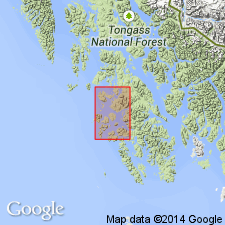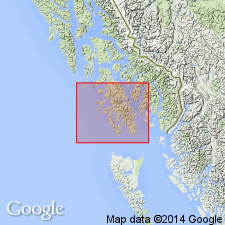
- Usage in publication:
-
- Wadleigh Limestone*
- Modifications:
-
- Named
- Biostratigraphic dating
- Dominant lithology:
-
- Limestone
- AAPG geologic province:
-
- Alaska Southeastern region
Summary:
Unit is named the Wadleigh Limestone. Consists of a medium- to dark-gray thick- to medium-bedded, massive, commonly fetid fragmented-fossil limestone, with argillaceous interbeds. Thickness is estimated at 1000 ft but could be as much as 2000 ft. Upper and lower contacts are nearly everywhere covered. Conformably overlies the Karheen Formation or Coronados Volcanics. Conformably underlies or is intercalated with the Port Refugio Formation or underlies the Peratrovich Formation. Age is Middle and Late Devonian age based on fossils [corals].
Source: GNU records (USGS DDS-6; Menlo GNULEX).

- Usage in publication:
-
- Wadleigh Limestone*
- Modifications:
-
- Age modified
- AAPG geologic province:
-
- Alaska Southeastern region
Summary:
Age of the Wadleigh Limestone is revised from Middle and Late Devonian to: Early to Late Devonian (everywhere).
Source: GNU records (USGS DDS-6; Menlo GNULEX).
For more information, please contact Nancy Stamm, Geologic Names Committee Secretary.
Asterisk (*) indicates published by U.S. Geological Survey authors.
"No current usage" (†) implies that a name has been abandoned or has fallen into disuse. Former usage and, if known, replacement name given in parentheses ( ).
Slash (/) indicates name conflicts with nomenclatural guidelines (CSN, 1933; ACSN, 1961, 1970; NACSN, 1983, 2005, 2021). May be explained within brackets ([ ]).

